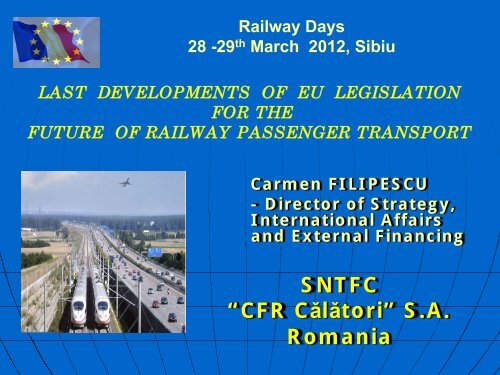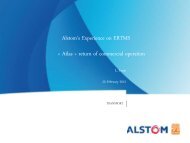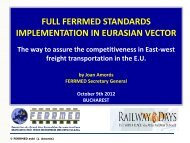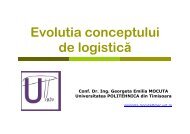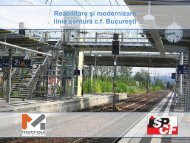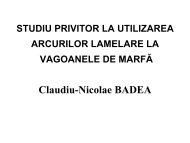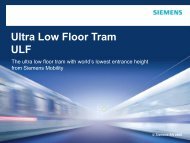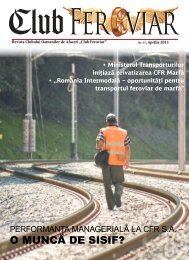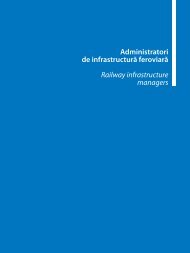Fourth Railway Package - Club Feroviar Conferences
Fourth Railway Package - Club Feroviar Conferences
Fourth Railway Package - Club Feroviar Conferences
You also want an ePaper? Increase the reach of your titles
YUMPU automatically turns print PDFs into web optimized ePapers that Google loves.
A Common European <strong>Railway</strong> areaThe main RAILWAY GOAL of EU :« Creation of an integrated European railway areato allow cross border services under a singleresponsibility in order to guarantee the quality ofservices to the customer »
EU Legislation1st railway package:• Directive 2001/12(modif. Directive 91/440) – development of EUrailways• Directive 2001/13 - licenses for RUs• Directive 2001/14 - infrastructure capacity allocation, track accesscharge and safety certificate2 nd railway package• Directive 2004/49 - safety of EU railways• Directive 2004/50 – interoperability of conventional an High speedrailways• Directive 2004/51- freight liberalization•Regulation 881/2004 – establishment of ERA3rd railway package• Directive 2007/58 - liberalization of international railway transport;• Directive 2007/59 - train drivers certification• Regulation 1370/2007 – Passengers Rights and Obligations (PRR)and R 1371/2007 - Public Service Contract (PSC)
Recast of First railway packageProposal COM (2010) 475 from 17 September 2010 for a EUDirective establishing a single European railway area • Major aim: to provide for a non-discriminatory competitionin the railway traffic market and to increase its marketshare.• Goals of the Directive:• adequate financing of and charging for rail infrastructures,• conditions of competition on the railway market,• organisational reforms needed to ensure appropriatesupervision of the market• Parties implicated:<strong>Railway</strong> undertakings, infrastructure managers andproviders of services related to rail traffic.
Implementation of existing legislation• The Commission has therefore moved to ensure that the existinglegislation is enforced by bringing infringement proceduresagainst Member States who have incorrectly or incompletelytransposed it.
Recast of First railway packageState of art:• First reading: Nov 2011- finalised• Informal trialogue talks underway to facilitate second reading• Second reading: to start officially in Spring 2012• Conclusion of ‘content-discussions’ by summer 2012 due topolitical constraints• State of the art – procedure:All parties wish to avoid conciliation: real will from bothsides to finalize the dossier and to move on to the next step (4th<strong>Railway</strong> <strong>Package</strong>)
Recast of First railway packageMain issues of concern for the second reading relate to:• non-discriminatory access to rail related services:passenger stations, freight terminals, marshalling yards, trainformation facilities, storage sidings, port facilities and relieffacilities, including towing;• setting up a fair financial architecture:it comprises many aspects (separation of accounts, financing of IM,charging rules, noise, ETCS, etc);• reinforcement of Regulatory Bodys’ powers and independenceas well as their cooperation in the form of a network of RBs.
<strong>Fourth</strong> <strong>Railway</strong> <strong>Package</strong>The Commission intends to propose a “<strong>Fourth</strong> <strong>Railway</strong> <strong>Package</strong>”in late Autumn 2012 and adopt it at the end of 2012 :• 1. Structural separation (unbundling)• 2. Domestic passenger market liberalisation• 3. Strengthening the role of the European Rail Agency (ERA),including a revision of the rail safety directive• 4. Proposals towards a European Regulatory Body / strongerEU coordination of regulatory bodiesScope: Consolidation of the railway transport market opening !
<strong>Fourth</strong> <strong>Railway</strong> <strong>Package</strong>1. Structural separation (unbundling)Non-discriminatory access to rail infrastructure in such a wayas to ensure:• the development of competition;• continued investment;• efficiency in the cost of service provision.Obs: Definition of ‘essential ’activities, and whether and howessential functions should be separated from the infrastructuremanager are the key questions that require a clear position.Structural models for the rail sector demand a new way ofthinking with a particular focus on how economic incentivesand good governance can be supported.
<strong>Fourth</strong> <strong>Railway</strong> <strong>Package</strong>2. Domestic passenger market liberalisation Introducing competition and market mechanisms contributes to:- increasing quality and productivity.- promote the integration of railway markets as well as;- fair competition between railway undertakings Non-discriminatory and transparent access to the European railwaynetwork has to be guaranteed;‣ Domestic passenger traffic liberalisation has to be implementedin a context where:‣ infrastructure and public service contracts are adequatelyfinanced while‣ respecting the economic equilibrium of such contracts inaccordance with existing EU legal requirements;
<strong>Fourth</strong> <strong>Railway</strong> <strong>Package</strong>3. Strengthening the role of the European Rail Agency (ERA),including a revision of the rail safety directive to achievea Single European <strong>Railway</strong> Area by establishing a single Europeanrailway vehicle authorisation.:Key OBJECTIVES:• Promoting the development of effective rail infrastructure;• • Establishing an attractive and genuinely open rail market;• • Removing administrative and technical barriers and developing easyand common procedures on European level;• • Ensuring a level playing field with other transport modesThe Commission wishes to improve the functioning of nationalsafety authorities and (if necessary) of the relevant notifiedbodies.
<strong>Fourth</strong> <strong>Railway</strong> <strong>Package</strong>3. Strengthening the role of the E.R.A.• Functions to be added to today’s competences of ERA• 1. ERA should be able to exercise the function of a one-stop shopfor vehicles authorisation of cross-border traffic;• 2. ERA should act as a one-stop shop for the granting of safetycertificates to RUs.• 3. ERA should have decision-making powers in the event ofdisputes about vehicle authorisation processes and/or safetycertificates
<strong>Fourth</strong> <strong>Railway</strong> <strong>Package</strong>4. Proposals towards a European Regulatory Body to havestronger coordination/cooperation between (national) regulatorybodies:• Contribute to the uniform application of EU law across Union;• Provide for a non-binding alternative dispute resolution system (i.e.arbitration) in cases of complaints involving cross-border services;• Report on an annual basis to the EU legislators and stakeholders onthe state of play of national regulators;• Provide pressure to national regulatory bodies.Main issue: Should RBs stay completely independent or is itnecessary an European Association as a supervisor?
Passenger Rights: ImplementationBy 3 rd December 2012 :European Commission must publish a Report on theImplementation of the CE /1371/2007 RegulationBy 30 th June 2012 : RU obligation to publish an AnnualReport and a Quality Report“ PRR art.28 al.2. “<strong>Railway</strong> undertakings shall monitor their ownperformance as reflected in the service quality standards. <strong>Railway</strong>undertakings shall each year publish a report on their servicequality performance together with their annual report. The reportson service quality performance shall be published on the Internetwebsite of the railway undertakings. In addition, these reportsshall be made available on the Internet website of the ERA “http://www.era.europa.eu/Core-Activities/Interoperability/Pages/Rail-PRR-QR.aspx
TAP TSI Regulation5 May 2011: the European Commission formally adopted theTelematics Applications for Passenger Services TechnicalSpecifications for Interoperability (TAP TSI).13 May 2011: it entered into force on as the Regulation (EU) No454/2011.The TAP TSI shall be implemented in three phases:• Phase 1 - Implementation preparation, containing detailed ITspecifications, a master plan and a governance model• Phase 2 - Development of the data exchange system• Phase 3 - Deployment of the data exchange system
TAP TSI Regulation - PurposePurpose: to define European-wide procedures andinterfaces between all types of railway industry actors:• passengers,• railway undertakings,• infrastructure managers,• station managers,• public transport authorities,• ticket vendors and tour operators.Contribution to:• an interoperable and cost-efficient information exchangesystem for Europe and• provision of high quality journey information• ticket issuing to passengers in a cost effective manner,thus also fulfilling requirements of PRR.
New chalenge!European Journey Planner“It is one of our ten main goals in the White Paper to establish theframework for a European multimodal transport information,management and payment system by 2020”.Commission’s Vice President KALLAS on 6 June 2011 in Lyon, FrancePassengers travel with:integrated information;integrated reservation systems as well assmart ticketingMultimodal travel is a key part of the European Commission’s strategyfor the future of transport, aimed at making transport more efficient andclean and ensuring high quality of service.
First Smart Mobility Challenge• On 6 June 2011, Vice-President Kallas, EU Commissioner fortransport, launched the First Smart Mobility Challenge to industryand the general public (2 phases: open until 15 October 2011- 13January 2012):1.Operational European (or at least cross-border)multimodal journey planners;2.New, bright ideas on how to develop a realEuropean multimodal journey planner• The winners: TRENITALIA, Idos, SNCF, Penelope Ventures• They will be invited to take part in the ITS World Congress in Viennaon 22-26 October 2012 where they will be able to present theirplanners and ideas at the Commission stand.
BIG CHALENGES for RUA New Attitude!
THANK YOU FOR YOUR ATTENTION!


